Case Study on Borderline Personality Disorder
VerifiedAdded on 2022/11/24
|14
|4371
|299
AI Summary
This case study explores the diagnosis, symptoms, and treatment plan for a patient with Borderline Personality Disorder (BPD). It discusses the impact of BPD on the patient's self-image, relationships, and mental health. The study also highlights various therapy approaches, including Dialectical Behavioral Therapy (DBT) and Schema therapy, that can help individuals with BPD lead a more stable and fulfilling life.
Contribute Materials
Your contribution can guide someone’s learning journey. Share your
documents today.

Running head: CASE STUDY
Case Study
Name of the student
Name of the university
Author’s name
Case Study
Name of the student
Name of the university
Author’s name
Secure Best Marks with AI Grader
Need help grading? Try our AI Grader for instant feedback on your assignments.
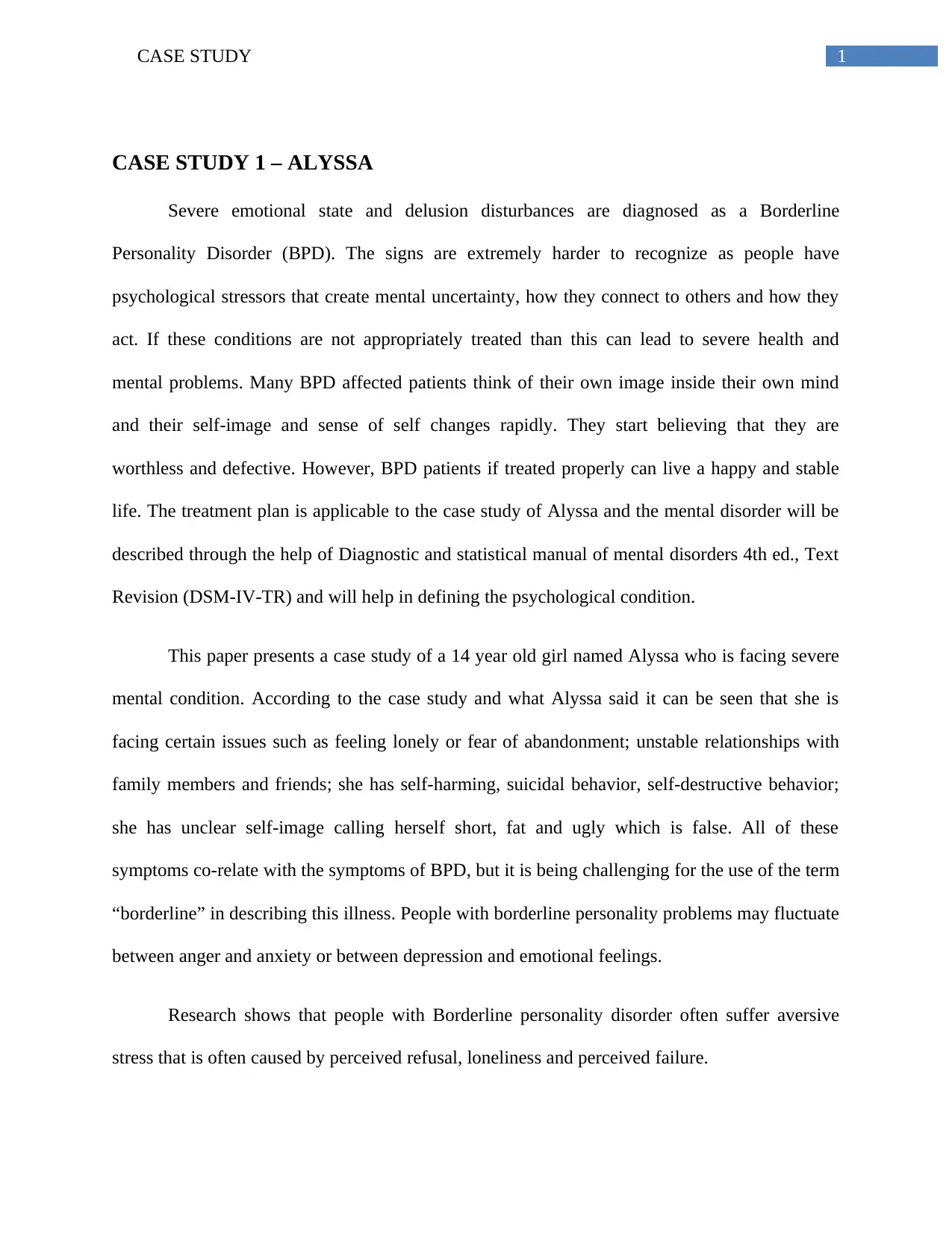
1CASE STUDY
CASE STUDY 1 – ALYSSA
Severe emotional state and delusion disturbances are diagnosed as a Borderline
Personality Disorder (BPD). The signs are extremely harder to recognize as people have
psychological stressors that create mental uncertainty, how they connect to others and how they
act. If these conditions are not appropriately treated than this can lead to severe health and
mental problems. Many BPD affected patients think of their own image inside their own mind
and their self-image and sense of self changes rapidly. They start believing that they are
worthless and defective. However, BPD patients if treated properly can live a happy and stable
life. The treatment plan is applicable to the case study of Alyssa and the mental disorder will be
described through the help of Diagnostic and statistical manual of mental disorders 4th ed., Text
Revision (DSM-IV-TR) and will help in defining the psychological condition.
This paper presents a case study of a 14 year old girl named Alyssa who is facing severe
mental condition. According to the case study and what Alyssa said it can be seen that she is
facing certain issues such as feeling lonely or fear of abandonment; unstable relationships with
family members and friends; she has self-harming, suicidal behavior, self-destructive behavior;
she has unclear self-image calling herself short, fat and ugly which is false. All of these
symptoms co-relate with the symptoms of BPD, but it is being challenging for the use of the term
“borderline” in describing this illness. People with borderline personality problems may fluctuate
between anger and anxiety or between depression and emotional feelings.
Research shows that people with Borderline personality disorder often suffer aversive
stress that is often caused by perceived refusal, loneliness and perceived failure.
CASE STUDY 1 – ALYSSA
Severe emotional state and delusion disturbances are diagnosed as a Borderline
Personality Disorder (BPD). The signs are extremely harder to recognize as people have
psychological stressors that create mental uncertainty, how they connect to others and how they
act. If these conditions are not appropriately treated than this can lead to severe health and
mental problems. Many BPD affected patients think of their own image inside their own mind
and their self-image and sense of self changes rapidly. They start believing that they are
worthless and defective. However, BPD patients if treated properly can live a happy and stable
life. The treatment plan is applicable to the case study of Alyssa and the mental disorder will be
described through the help of Diagnostic and statistical manual of mental disorders 4th ed., Text
Revision (DSM-IV-TR) and will help in defining the psychological condition.
This paper presents a case study of a 14 year old girl named Alyssa who is facing severe
mental condition. According to the case study and what Alyssa said it can be seen that she is
facing certain issues such as feeling lonely or fear of abandonment; unstable relationships with
family members and friends; she has self-harming, suicidal behavior, self-destructive behavior;
she has unclear self-image calling herself short, fat and ugly which is false. All of these
symptoms co-relate with the symptoms of BPD, but it is being challenging for the use of the term
“borderline” in describing this illness. People with borderline personality problems may fluctuate
between anger and anxiety or between depression and emotional feelings.
Research shows that people with Borderline personality disorder often suffer aversive
stress that is often caused by perceived refusal, loneliness and perceived failure.
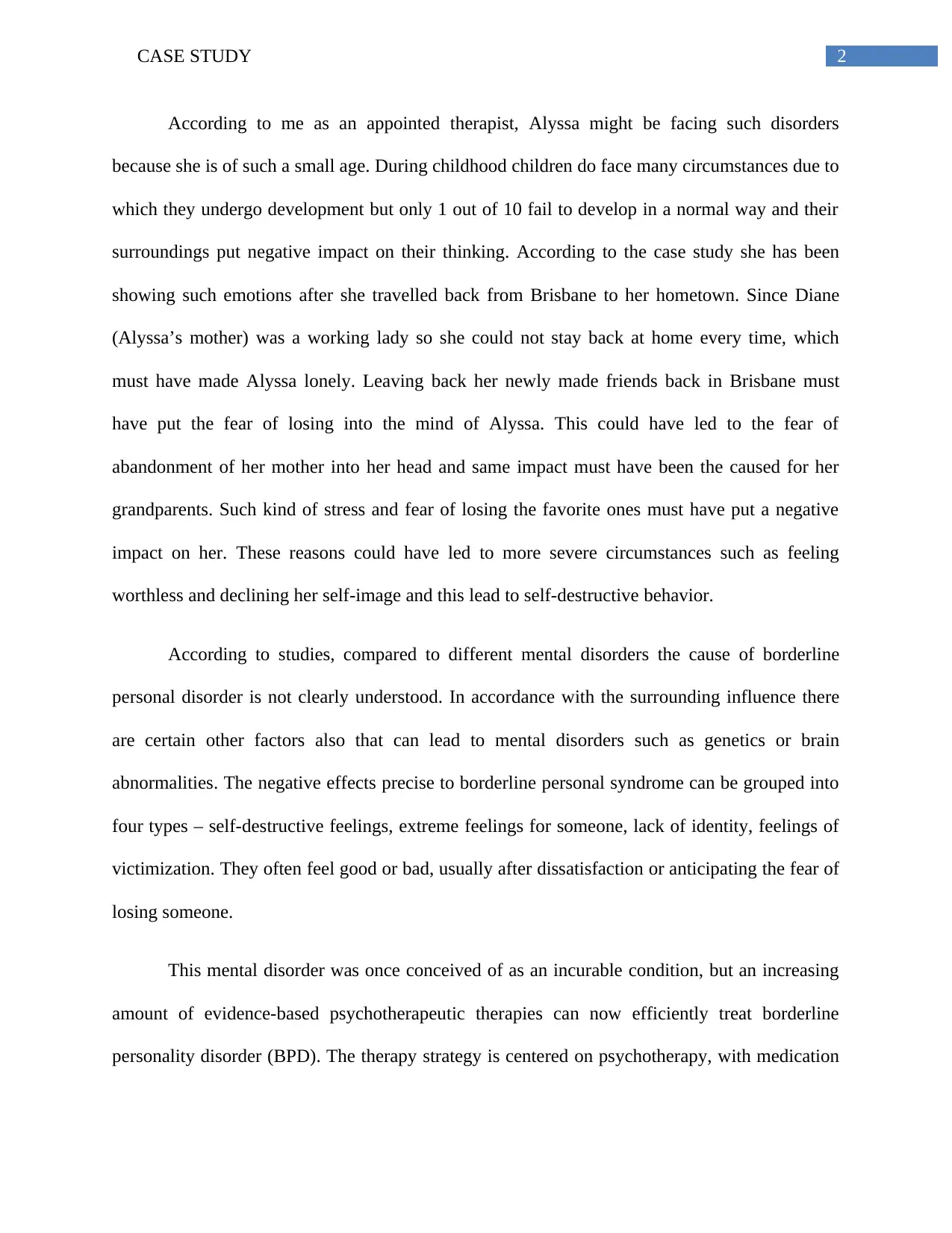
2CASE STUDY
According to me as an appointed therapist, Alyssa might be facing such disorders
because she is of such a small age. During childhood children do face many circumstances due to
which they undergo development but only 1 out of 10 fail to develop in a normal way and their
surroundings put negative impact on their thinking. According to the case study she has been
showing such emotions after she travelled back from Brisbane to her hometown. Since Diane
(Alyssa’s mother) was a working lady so she could not stay back at home every time, which
must have made Alyssa lonely. Leaving back her newly made friends back in Brisbane must
have put the fear of losing into the mind of Alyssa. This could have led to the fear of
abandonment of her mother into her head and same impact must have been the caused for her
grandparents. Such kind of stress and fear of losing the favorite ones must have put a negative
impact on her. These reasons could have led to more severe circumstances such as feeling
worthless and declining her self-image and this lead to self-destructive behavior.
According to studies, compared to different mental disorders the cause of borderline
personal disorder is not clearly understood. In accordance with the surrounding influence there
are certain other factors also that can lead to mental disorders such as genetics or brain
abnormalities. The negative effects precise to borderline personal syndrome can be grouped into
four types – self-destructive feelings, extreme feelings for someone, lack of identity, feelings of
victimization. They often feel good or bad, usually after dissatisfaction or anticipating the fear of
losing someone.
This mental disorder was once conceived of as an incurable condition, but an increasing
amount of evidence-based psychotherapeutic therapies can now efficiently treat borderline
personality disorder (BPD). The therapy strategy is centered on psychotherapy, with medication
According to me as an appointed therapist, Alyssa might be facing such disorders
because she is of such a small age. During childhood children do face many circumstances due to
which they undergo development but only 1 out of 10 fail to develop in a normal way and their
surroundings put negative impact on their thinking. According to the case study she has been
showing such emotions after she travelled back from Brisbane to her hometown. Since Diane
(Alyssa’s mother) was a working lady so she could not stay back at home every time, which
must have made Alyssa lonely. Leaving back her newly made friends back in Brisbane must
have put the fear of losing into the mind of Alyssa. This could have led to the fear of
abandonment of her mother into her head and same impact must have been the caused for her
grandparents. Such kind of stress and fear of losing the favorite ones must have put a negative
impact on her. These reasons could have led to more severe circumstances such as feeling
worthless and declining her self-image and this lead to self-destructive behavior.
According to studies, compared to different mental disorders the cause of borderline
personal disorder is not clearly understood. In accordance with the surrounding influence there
are certain other factors also that can lead to mental disorders such as genetics or brain
abnormalities. The negative effects precise to borderline personal syndrome can be grouped into
four types – self-destructive feelings, extreme feelings for someone, lack of identity, feelings of
victimization. They often feel good or bad, usually after dissatisfaction or anticipating the fear of
losing someone.
This mental disorder was once conceived of as an incurable condition, but an increasing
amount of evidence-based psychotherapeutic therapies can now efficiently treat borderline
personality disorder (BPD). The therapy strategy is centered on psychotherapy, with medication
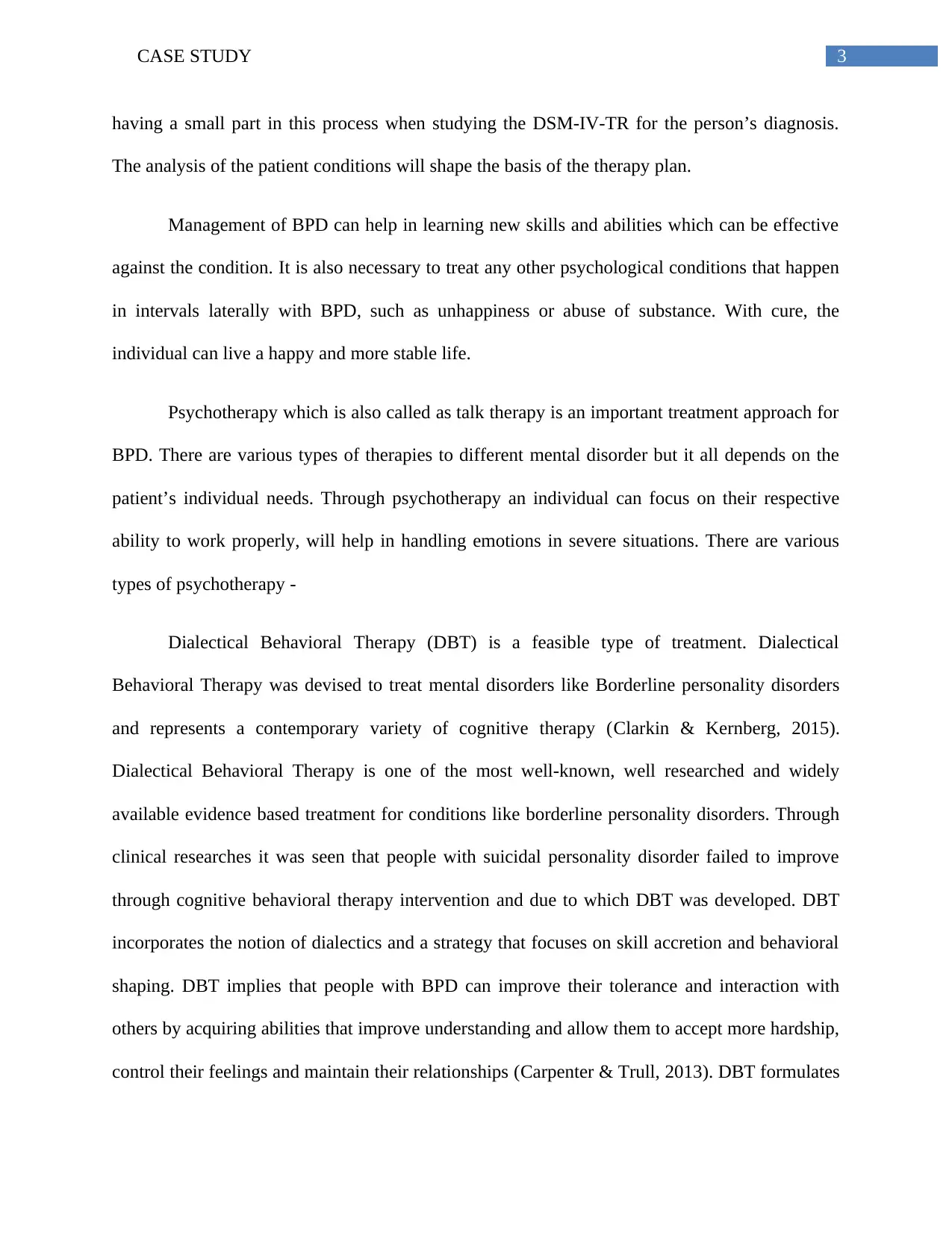
3CASE STUDY
having a small part in this process when studying the DSM-IV-TR for the person’s diagnosis.
The analysis of the patient conditions will shape the basis of the therapy plan.
Management of BPD can help in learning new skills and abilities which can be effective
against the condition. It is also necessary to treat any other psychological conditions that happen
in intervals laterally with BPD, such as unhappiness or abuse of substance. With cure, the
individual can live a happy and more stable life.
Psychotherapy which is also called as talk therapy is an important treatment approach for
BPD. There are various types of therapies to different mental disorder but it all depends on the
patient’s individual needs. Through psychotherapy an individual can focus on their respective
ability to work properly, will help in handling emotions in severe situations. There are various
types of psychotherapy -
Dialectical Behavioral Therapy (DBT) is a feasible type of treatment. Dialectical
Behavioral Therapy was devised to treat mental disorders like Borderline personality disorders
and represents a contemporary variety of cognitive therapy (Clarkin & Kernberg, 2015).
Dialectical Behavioral Therapy is one of the most well-known, well researched and widely
available evidence based treatment for conditions like borderline personality disorders. Through
clinical researches it was seen that people with suicidal personality disorder failed to improve
through cognitive behavioral therapy intervention and due to which DBT was developed. DBT
incorporates the notion of dialectics and a strategy that focuses on skill accretion and behavioral
shaping. DBT implies that people with BPD can improve their tolerance and interaction with
others by acquiring abilities that improve understanding and allow them to accept more hardship,
control their feelings and maintain their relationships (Carpenter & Trull, 2013). DBT formulates
having a small part in this process when studying the DSM-IV-TR for the person’s diagnosis.
The analysis of the patient conditions will shape the basis of the therapy plan.
Management of BPD can help in learning new skills and abilities which can be effective
against the condition. It is also necessary to treat any other psychological conditions that happen
in intervals laterally with BPD, such as unhappiness or abuse of substance. With cure, the
individual can live a happy and more stable life.
Psychotherapy which is also called as talk therapy is an important treatment approach for
BPD. There are various types of therapies to different mental disorder but it all depends on the
patient’s individual needs. Through psychotherapy an individual can focus on their respective
ability to work properly, will help in handling emotions in severe situations. There are various
types of psychotherapy -
Dialectical Behavioral Therapy (DBT) is a feasible type of treatment. Dialectical
Behavioral Therapy was devised to treat mental disorders like Borderline personality disorders
and represents a contemporary variety of cognitive therapy (Clarkin & Kernberg, 2015).
Dialectical Behavioral Therapy is one of the most well-known, well researched and widely
available evidence based treatment for conditions like borderline personality disorders. Through
clinical researches it was seen that people with suicidal personality disorder failed to improve
through cognitive behavioral therapy intervention and due to which DBT was developed. DBT
incorporates the notion of dialectics and a strategy that focuses on skill accretion and behavioral
shaping. DBT implies that people with BPD can improve their tolerance and interaction with
others by acquiring abilities that improve understanding and allow them to accept more hardship,
control their feelings and maintain their relationships (Carpenter & Trull, 2013). DBT formulates
Secure Best Marks with AI Grader
Need help grading? Try our AI Grader for instant feedback on your assignments.
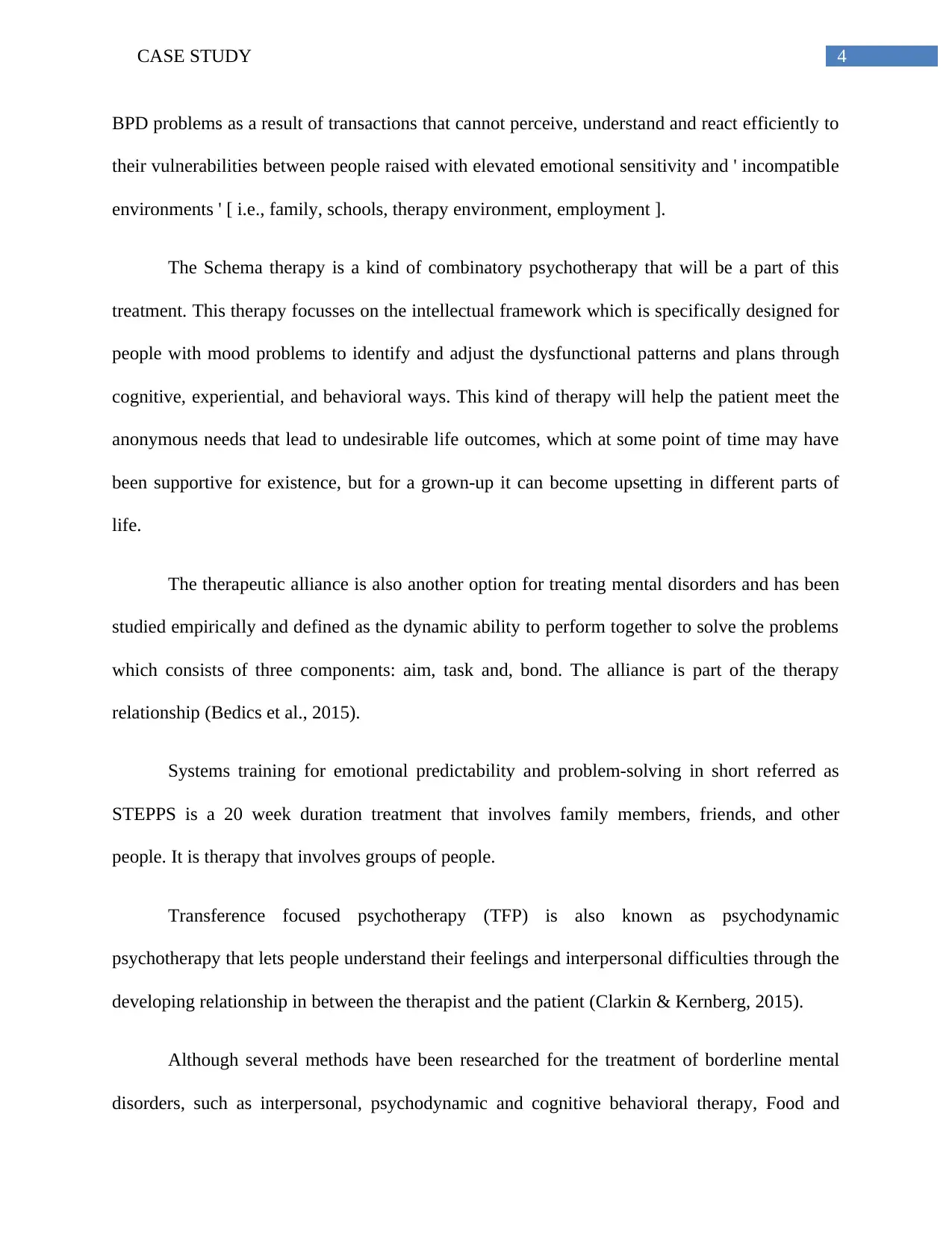
4CASE STUDY
BPD problems as a result of transactions that cannot perceive, understand and react efficiently to
their vulnerabilities between people raised with elevated emotional sensitivity and ' incompatible
environments ' [ i.e., family, schools, therapy environment, employment ].
The Schema therapy is a kind of combinatory psychotherapy that will be a part of this
treatment. This therapy focusses on the intellectual framework which is specifically designed for
people with mood problems to identify and adjust the dysfunctional patterns and plans through
cognitive, experiential, and behavioral ways. This kind of therapy will help the patient meet the
anonymous needs that lead to undesirable life outcomes, which at some point of time may have
been supportive for existence, but for a grown-up it can become upsetting in different parts of
life.
The therapeutic alliance is also another option for treating mental disorders and has been
studied empirically and defined as the dynamic ability to perform together to solve the problems
which consists of three components: aim, task and, bond. The alliance is part of the therapy
relationship (Bedics et al., 2015).
Systems training for emotional predictability and problem-solving in short referred as
STEPPS is a 20 week duration treatment that involves family members, friends, and other
people. It is therapy that involves groups of people.
Transference focused psychotherapy (TFP) is also known as psychodynamic
psychotherapy that lets people understand their feelings and interpersonal difficulties through the
developing relationship in between the therapist and the patient (Clarkin & Kernberg, 2015).
Although several methods have been researched for the treatment of borderline mental
disorders, such as interpersonal, psychodynamic and cognitive behavioral therapy, Food and
BPD problems as a result of transactions that cannot perceive, understand and react efficiently to
their vulnerabilities between people raised with elevated emotional sensitivity and ' incompatible
environments ' [ i.e., family, schools, therapy environment, employment ].
The Schema therapy is a kind of combinatory psychotherapy that will be a part of this
treatment. This therapy focusses on the intellectual framework which is specifically designed for
people with mood problems to identify and adjust the dysfunctional patterns and plans through
cognitive, experiential, and behavioral ways. This kind of therapy will help the patient meet the
anonymous needs that lead to undesirable life outcomes, which at some point of time may have
been supportive for existence, but for a grown-up it can become upsetting in different parts of
life.
The therapeutic alliance is also another option for treating mental disorders and has been
studied empirically and defined as the dynamic ability to perform together to solve the problems
which consists of three components: aim, task and, bond. The alliance is part of the therapy
relationship (Bedics et al., 2015).
Systems training for emotional predictability and problem-solving in short referred as
STEPPS is a 20 week duration treatment that involves family members, friends, and other
people. It is therapy that involves groups of people.
Transference focused psychotherapy (TFP) is also known as psychodynamic
psychotherapy that lets people understand their feelings and interpersonal difficulties through the
developing relationship in between the therapist and the patient (Clarkin & Kernberg, 2015).
Although several methods have been researched for the treatment of borderline mental
disorders, such as interpersonal, psychodynamic and cognitive behavioral therapy, Food and
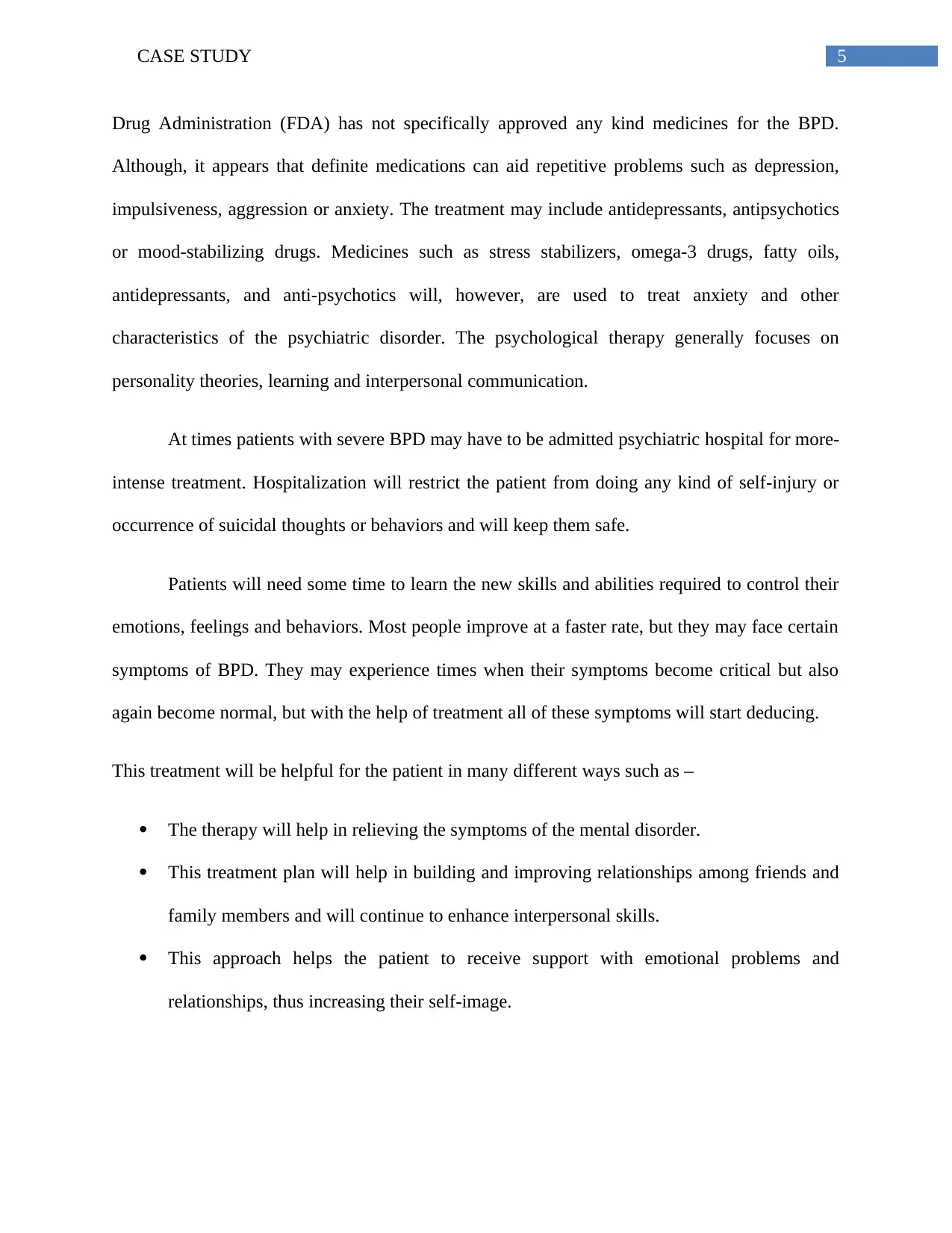
5CASE STUDY
Drug Administration (FDA) has not specifically approved any kind medicines for the BPD.
Although, it appears that definite medications can aid repetitive problems such as depression,
impulsiveness, aggression or anxiety. The treatment may include antidepressants, antipsychotics
or mood-stabilizing drugs. Medicines such as stress stabilizers, omega-3 drugs, fatty oils,
antidepressants, and anti-psychotics will, however, are used to treat anxiety and other
characteristics of the psychiatric disorder. The psychological therapy generally focuses on
personality theories, learning and interpersonal communication.
At times patients with severe BPD may have to be admitted psychiatric hospital for more-
intense treatment. Hospitalization will restrict the patient from doing any kind of self-injury or
occurrence of suicidal thoughts or behaviors and will keep them safe.
Patients will need some time to learn the new skills and abilities required to control their
emotions, feelings and behaviors. Most people improve at a faster rate, but they may face certain
symptoms of BPD. They may experience times when their symptoms become critical but also
again become normal, but with the help of treatment all of these symptoms will start deducing.
This treatment will be helpful for the patient in many different ways such as –
The therapy will help in relieving the symptoms of the mental disorder.
This treatment plan will help in building and improving relationships among friends and
family members and will continue to enhance interpersonal skills.
This approach helps the patient to receive support with emotional problems and
relationships, thus increasing their self-image.
Drug Administration (FDA) has not specifically approved any kind medicines for the BPD.
Although, it appears that definite medications can aid repetitive problems such as depression,
impulsiveness, aggression or anxiety. The treatment may include antidepressants, antipsychotics
or mood-stabilizing drugs. Medicines such as stress stabilizers, omega-3 drugs, fatty oils,
antidepressants, and anti-psychotics will, however, are used to treat anxiety and other
characteristics of the psychiatric disorder. The psychological therapy generally focuses on
personality theories, learning and interpersonal communication.
At times patients with severe BPD may have to be admitted psychiatric hospital for more-
intense treatment. Hospitalization will restrict the patient from doing any kind of self-injury or
occurrence of suicidal thoughts or behaviors and will keep them safe.
Patients will need some time to learn the new skills and abilities required to control their
emotions, feelings and behaviors. Most people improve at a faster rate, but they may face certain
symptoms of BPD. They may experience times when their symptoms become critical but also
again become normal, but with the help of treatment all of these symptoms will start deducing.
This treatment will be helpful for the patient in many different ways such as –
The therapy will help in relieving the symptoms of the mental disorder.
This treatment plan will help in building and improving relationships among friends and
family members and will continue to enhance interpersonal skills.
This approach helps the patient to receive support with emotional problems and
relationships, thus increasing their self-image.
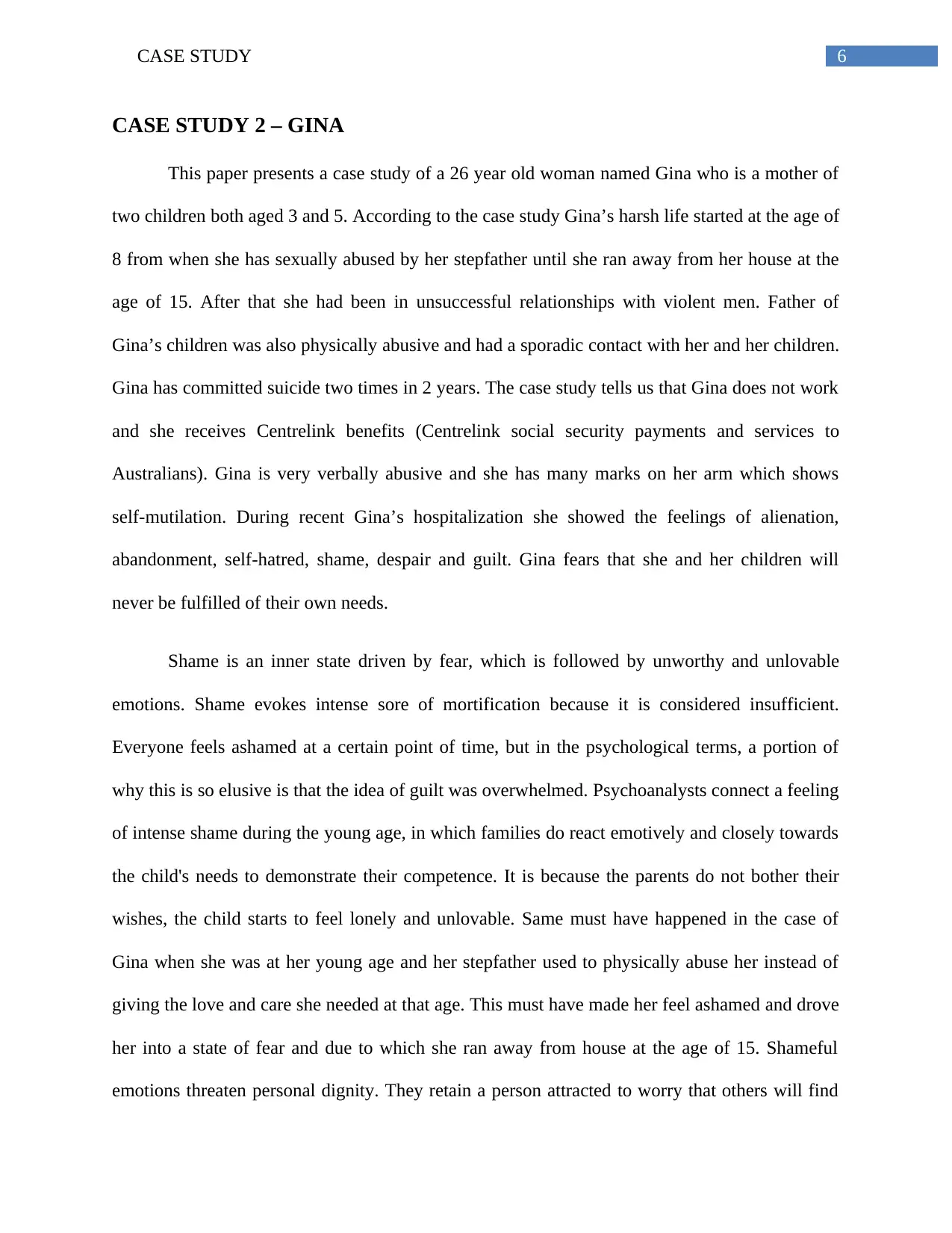
6CASE STUDY
CASE STUDY 2 – GINA
This paper presents a case study of a 26 year old woman named Gina who is a mother of
two children both aged 3 and 5. According to the case study Gina’s harsh life started at the age of
8 from when she has sexually abused by her stepfather until she ran away from her house at the
age of 15. After that she had been in unsuccessful relationships with violent men. Father of
Gina’s children was also physically abusive and had a sporadic contact with her and her children.
Gina has committed suicide two times in 2 years. The case study tells us that Gina does not work
and she receives Centrelink benefits (Centrelink social security payments and services to
Australians). Gina is very verbally abusive and she has many marks on her arm which shows
self-mutilation. During recent Gina’s hospitalization she showed the feelings of alienation,
abandonment, self-hatred, shame, despair and guilt. Gina fears that she and her children will
never be fulfilled of their own needs.
Shame is an inner state driven by fear, which is followed by unworthy and unlovable
emotions. Shame evokes intense sore of mortification because it is considered insufficient.
Everyone feels ashamed at a certain point of time, but in the psychological terms, a portion of
why this is so elusive is that the idea of guilt was overwhelmed. Psychoanalysts connect a feeling
of intense shame during the young age, in which families do react emotively and closely towards
the child's needs to demonstrate their competence. It is because the parents do not bother their
wishes, the child starts to feel lonely and unlovable. Same must have happened in the case of
Gina when she was at her young age and her stepfather used to physically abuse her instead of
giving the love and care she needed at that age. This must have made her feel ashamed and drove
her into a state of fear and due to which she ran away from house at the age of 15. Shameful
emotions threaten personal dignity. They retain a person attracted to worry that others will find
CASE STUDY 2 – GINA
This paper presents a case study of a 26 year old woman named Gina who is a mother of
two children both aged 3 and 5. According to the case study Gina’s harsh life started at the age of
8 from when she has sexually abused by her stepfather until she ran away from her house at the
age of 15. After that she had been in unsuccessful relationships with violent men. Father of
Gina’s children was also physically abusive and had a sporadic contact with her and her children.
Gina has committed suicide two times in 2 years. The case study tells us that Gina does not work
and she receives Centrelink benefits (Centrelink social security payments and services to
Australians). Gina is very verbally abusive and she has many marks on her arm which shows
self-mutilation. During recent Gina’s hospitalization she showed the feelings of alienation,
abandonment, self-hatred, shame, despair and guilt. Gina fears that she and her children will
never be fulfilled of their own needs.
Shame is an inner state driven by fear, which is followed by unworthy and unlovable
emotions. Shame evokes intense sore of mortification because it is considered insufficient.
Everyone feels ashamed at a certain point of time, but in the psychological terms, a portion of
why this is so elusive is that the idea of guilt was overwhelmed. Psychoanalysts connect a feeling
of intense shame during the young age, in which families do react emotively and closely towards
the child's needs to demonstrate their competence. It is because the parents do not bother their
wishes, the child starts to feel lonely and unlovable. Same must have happened in the case of
Gina when she was at her young age and her stepfather used to physically abuse her instead of
giving the love and care she needed at that age. This must have made her feel ashamed and drove
her into a state of fear and due to which she ran away from house at the age of 15. Shameful
emotions threaten personal dignity. They retain a person attracted to worry that others will find
Paraphrase This Document
Need a fresh take? Get an instant paraphrase of this document with our AI Paraphraser
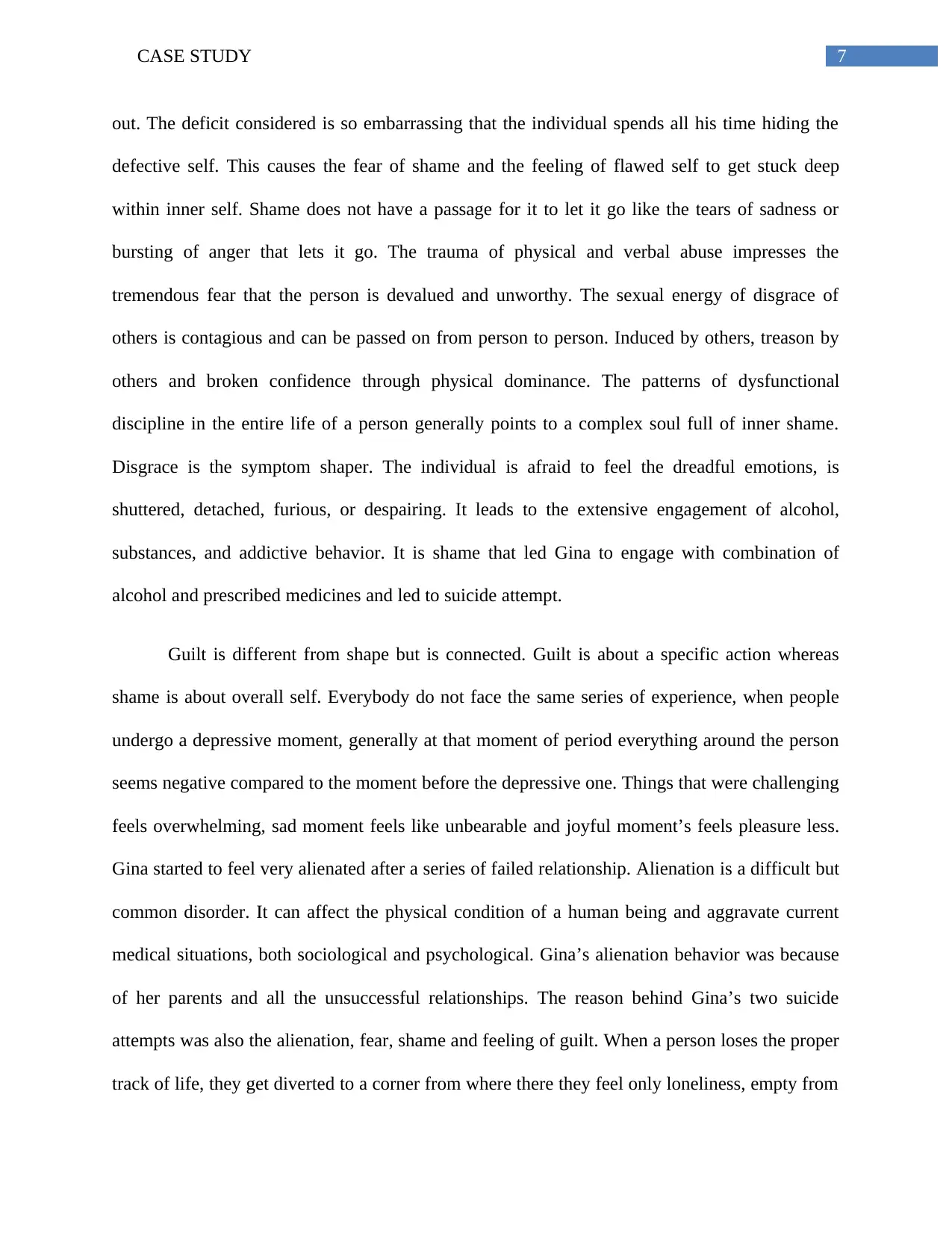
7CASE STUDY
out. The deficit considered is so embarrassing that the individual spends all his time hiding the
defective self. This causes the fear of shame and the feeling of flawed self to get stuck deep
within inner self. Shame does not have a passage for it to let it go like the tears of sadness or
bursting of anger that lets it go. The trauma of physical and verbal abuse impresses the
tremendous fear that the person is devalued and unworthy. The sexual energy of disgrace of
others is contagious and can be passed on from person to person. Induced by others, treason by
others and broken confidence through physical dominance. The patterns of dysfunctional
discipline in the entire life of a person generally points to a complex soul full of inner shame.
Disgrace is the symptom shaper. The individual is afraid to feel the dreadful emotions, is
shuttered, detached, furious, or despairing. It leads to the extensive engagement of alcohol,
substances, and addictive behavior. It is shame that led Gina to engage with combination of
alcohol and prescribed medicines and led to suicide attempt.
Guilt is different from shape but is connected. Guilt is about a specific action whereas
shame is about overall self. Everybody do not face the same series of experience, when people
undergo a depressive moment, generally at that moment of period everything around the person
seems negative compared to the moment before the depressive one. Things that were challenging
feels overwhelming, sad moment feels like unbearable and joyful moment’s feels pleasure less.
Gina started to feel very alienated after a series of failed relationship. Alienation is a difficult but
common disorder. It can affect the physical condition of a human being and aggravate current
medical situations, both sociological and psychological. Gina’s alienation behavior was because
of her parents and all the unsuccessful relationships. The reason behind Gina’s two suicide
attempts was also the alienation, fear, shame and feeling of guilt. When a person loses the proper
track of life, they get diverted to a corner from where there they feel only loneliness, empty from
out. The deficit considered is so embarrassing that the individual spends all his time hiding the
defective self. This causes the fear of shame and the feeling of flawed self to get stuck deep
within inner self. Shame does not have a passage for it to let it go like the tears of sadness or
bursting of anger that lets it go. The trauma of physical and verbal abuse impresses the
tremendous fear that the person is devalued and unworthy. The sexual energy of disgrace of
others is contagious and can be passed on from person to person. Induced by others, treason by
others and broken confidence through physical dominance. The patterns of dysfunctional
discipline in the entire life of a person generally points to a complex soul full of inner shame.
Disgrace is the symptom shaper. The individual is afraid to feel the dreadful emotions, is
shuttered, detached, furious, or despairing. It leads to the extensive engagement of alcohol,
substances, and addictive behavior. It is shame that led Gina to engage with combination of
alcohol and prescribed medicines and led to suicide attempt.
Guilt is different from shape but is connected. Guilt is about a specific action whereas
shame is about overall self. Everybody do not face the same series of experience, when people
undergo a depressive moment, generally at that moment of period everything around the person
seems negative compared to the moment before the depressive one. Things that were challenging
feels overwhelming, sad moment feels like unbearable and joyful moment’s feels pleasure less.
Gina started to feel very alienated after a series of failed relationship. Alienation is a difficult but
common disorder. It can affect the physical condition of a human being and aggravate current
medical situations, both sociological and psychological. Gina’s alienation behavior was because
of her parents and all the unsuccessful relationships. The reason behind Gina’s two suicide
attempts was also the alienation, fear, shame and feeling of guilt. When a person loses the proper
track of life, they get diverted to a corner from where there they feel only loneliness, empty from
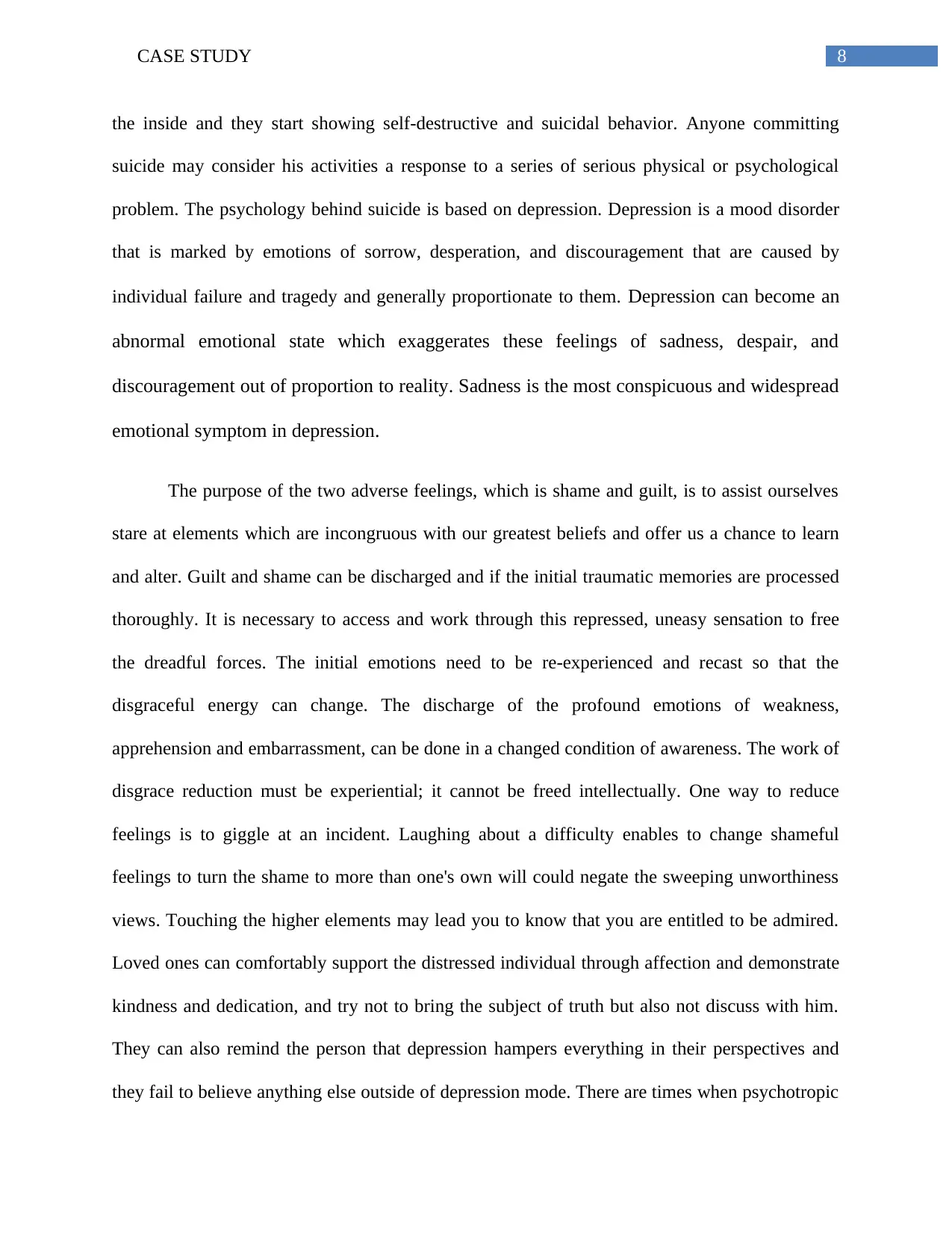
8CASE STUDY
the inside and they start showing self-destructive and suicidal behavior. Anyone committing
suicide may consider his activities a response to a series of serious physical or psychological
problem. The psychology behind suicide is based on depression. Depression is a mood disorder
that is marked by emotions of sorrow, desperation, and discouragement that are caused by
individual failure and tragedy and generally proportionate to them. Depression can become an
abnormal emotional state which exaggerates these feelings of sadness, despair, and
discouragement out of proportion to reality. Sadness is the most conspicuous and widespread
emotional symptom in depression.
The purpose of the two adverse feelings, which is shame and guilt, is to assist ourselves
stare at elements which are incongruous with our greatest beliefs and offer us a chance to learn
and alter. Guilt and shame can be discharged and if the initial traumatic memories are processed
thoroughly. It is necessary to access and work through this repressed, uneasy sensation to free
the dreadful forces. The initial emotions need to be re-experienced and recast so that the
disgraceful energy can change. The discharge of the profound emotions of weakness,
apprehension and embarrassment, can be done in a changed condition of awareness. The work of
disgrace reduction must be experiential; it cannot be freed intellectually. One way to reduce
feelings is to giggle at an incident. Laughing about a difficulty enables to change shameful
feelings to turn the shame to more than one's own will could negate the sweeping unworthiness
views. Touching the higher elements may lead you to know that you are entitled to be admired.
Loved ones can comfortably support the distressed individual through affection and demonstrate
kindness and dedication, and try not to bring the subject of truth but also not discuss with him.
They can also remind the person that depression hampers everything in their perspectives and
they fail to believe anything else outside of depression mode. There are times when psychotropic
the inside and they start showing self-destructive and suicidal behavior. Anyone committing
suicide may consider his activities a response to a series of serious physical or psychological
problem. The psychology behind suicide is based on depression. Depression is a mood disorder
that is marked by emotions of sorrow, desperation, and discouragement that are caused by
individual failure and tragedy and generally proportionate to them. Depression can become an
abnormal emotional state which exaggerates these feelings of sadness, despair, and
discouragement out of proportion to reality. Sadness is the most conspicuous and widespread
emotional symptom in depression.
The purpose of the two adverse feelings, which is shame and guilt, is to assist ourselves
stare at elements which are incongruous with our greatest beliefs and offer us a chance to learn
and alter. Guilt and shame can be discharged and if the initial traumatic memories are processed
thoroughly. It is necessary to access and work through this repressed, uneasy sensation to free
the dreadful forces. The initial emotions need to be re-experienced and recast so that the
disgraceful energy can change. The discharge of the profound emotions of weakness,
apprehension and embarrassment, can be done in a changed condition of awareness. The work of
disgrace reduction must be experiential; it cannot be freed intellectually. One way to reduce
feelings is to giggle at an incident. Laughing about a difficulty enables to change shameful
feelings to turn the shame to more than one's own will could negate the sweeping unworthiness
views. Touching the higher elements may lead you to know that you are entitled to be admired.
Loved ones can comfortably support the distressed individual through affection and demonstrate
kindness and dedication, and try not to bring the subject of truth but also not discuss with him.
They can also remind the person that depression hampers everything in their perspectives and
they fail to believe anything else outside of depression mode. There are times when psychotropic
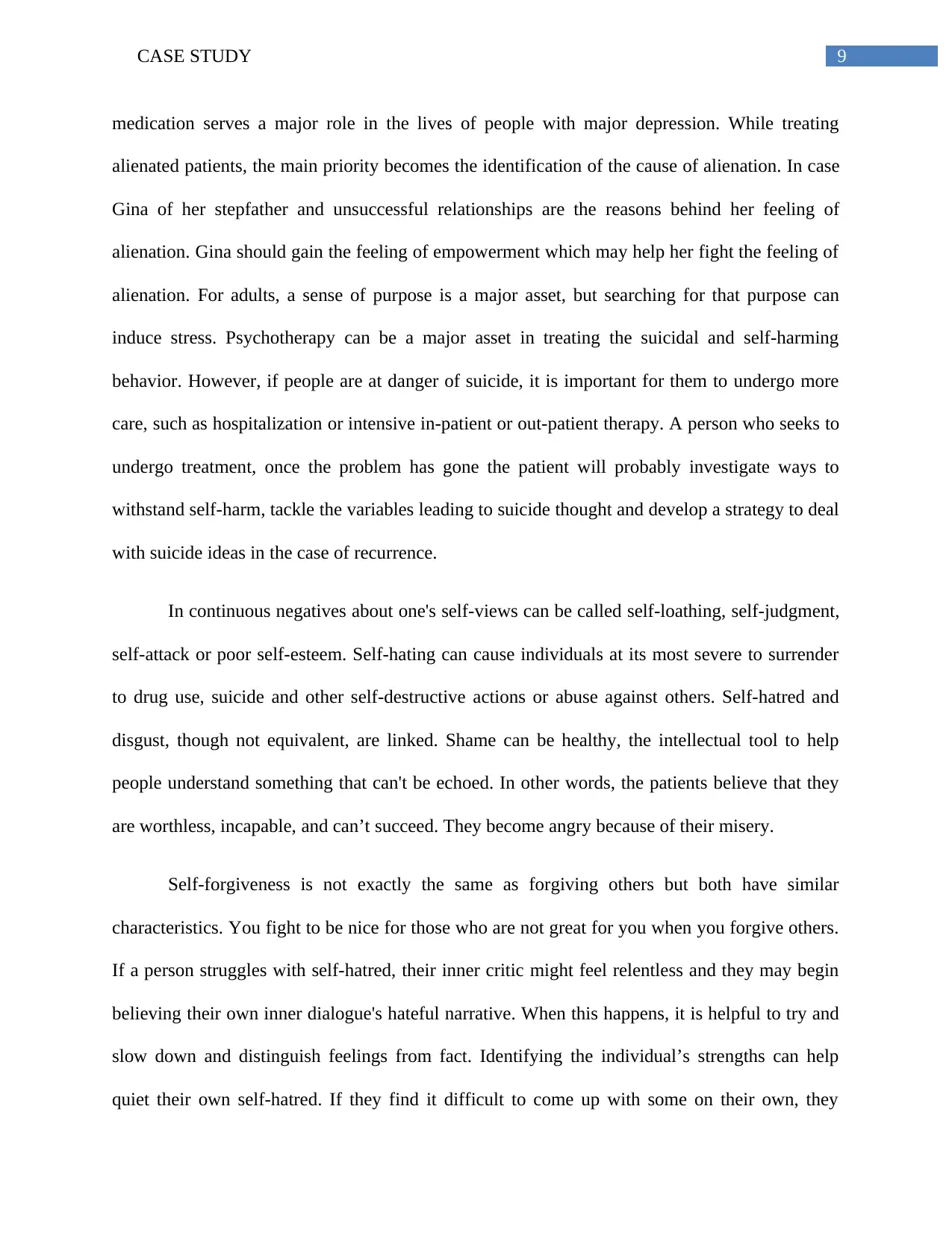
9CASE STUDY
medication serves a major role in the lives of people with major depression. While treating
alienated patients, the main priority becomes the identification of the cause of alienation. In case
Gina of her stepfather and unsuccessful relationships are the reasons behind her feeling of
alienation. Gina should gain the feeling of empowerment which may help her fight the feeling of
alienation. For adults, a sense of purpose is a major asset, but searching for that purpose can
induce stress. Psychotherapy can be a major asset in treating the suicidal and self-harming
behavior. However, if people are at danger of suicide, it is important for them to undergo more
care, such as hospitalization or intensive in-patient or out-patient therapy. A person who seeks to
undergo treatment, once the problem has gone the patient will probably investigate ways to
withstand self-harm, tackle the variables leading to suicide thought and develop a strategy to deal
with suicide ideas in the case of recurrence.
In continuous negatives about one's self-views can be called self-loathing, self-judgment,
self-attack or poor self-esteem. Self-hating can cause individuals at its most severe to surrender
to drug use, suicide and other self-destructive actions or abuse against others. Self-hatred and
disgust, though not equivalent, are linked. Shame can be healthy, the intellectual tool to help
people understand something that can't be echoed. In other words, the patients believe that they
are worthless, incapable, and can’t succeed. They become angry because of their misery.
Self-forgiveness is not exactly the same as forgiving others but both have similar
characteristics. You fight to be nice for those who are not great for you when you forgive others.
If a person struggles with self-hatred, their inner critic might feel relentless and they may begin
believing their own inner dialogue's hateful narrative. When this happens, it is helpful to try and
slow down and distinguish feelings from fact. Identifying the individual’s strengths can help
quiet their own self-hatred. If they find it difficult to come up with some on their own, they
medication serves a major role in the lives of people with major depression. While treating
alienated patients, the main priority becomes the identification of the cause of alienation. In case
Gina of her stepfather and unsuccessful relationships are the reasons behind her feeling of
alienation. Gina should gain the feeling of empowerment which may help her fight the feeling of
alienation. For adults, a sense of purpose is a major asset, but searching for that purpose can
induce stress. Psychotherapy can be a major asset in treating the suicidal and self-harming
behavior. However, if people are at danger of suicide, it is important for them to undergo more
care, such as hospitalization or intensive in-patient or out-patient therapy. A person who seeks to
undergo treatment, once the problem has gone the patient will probably investigate ways to
withstand self-harm, tackle the variables leading to suicide thought and develop a strategy to deal
with suicide ideas in the case of recurrence.
In continuous negatives about one's self-views can be called self-loathing, self-judgment,
self-attack or poor self-esteem. Self-hating can cause individuals at its most severe to surrender
to drug use, suicide and other self-destructive actions or abuse against others. Self-hatred and
disgust, though not equivalent, are linked. Shame can be healthy, the intellectual tool to help
people understand something that can't be echoed. In other words, the patients believe that they
are worthless, incapable, and can’t succeed. They become angry because of their misery.
Self-forgiveness is not exactly the same as forgiving others but both have similar
characteristics. You fight to be nice for those who are not great for you when you forgive others.
If a person struggles with self-hatred, their inner critic might feel relentless and they may begin
believing their own inner dialogue's hateful narrative. When this happens, it is helpful to try and
slow down and distinguish feelings from fact. Identifying the individual’s strengths can help
quiet their own self-hatred. If they find it difficult to come up with some on their own, they
Secure Best Marks with AI Grader
Need help grading? Try our AI Grader for instant feedback on your assignments.
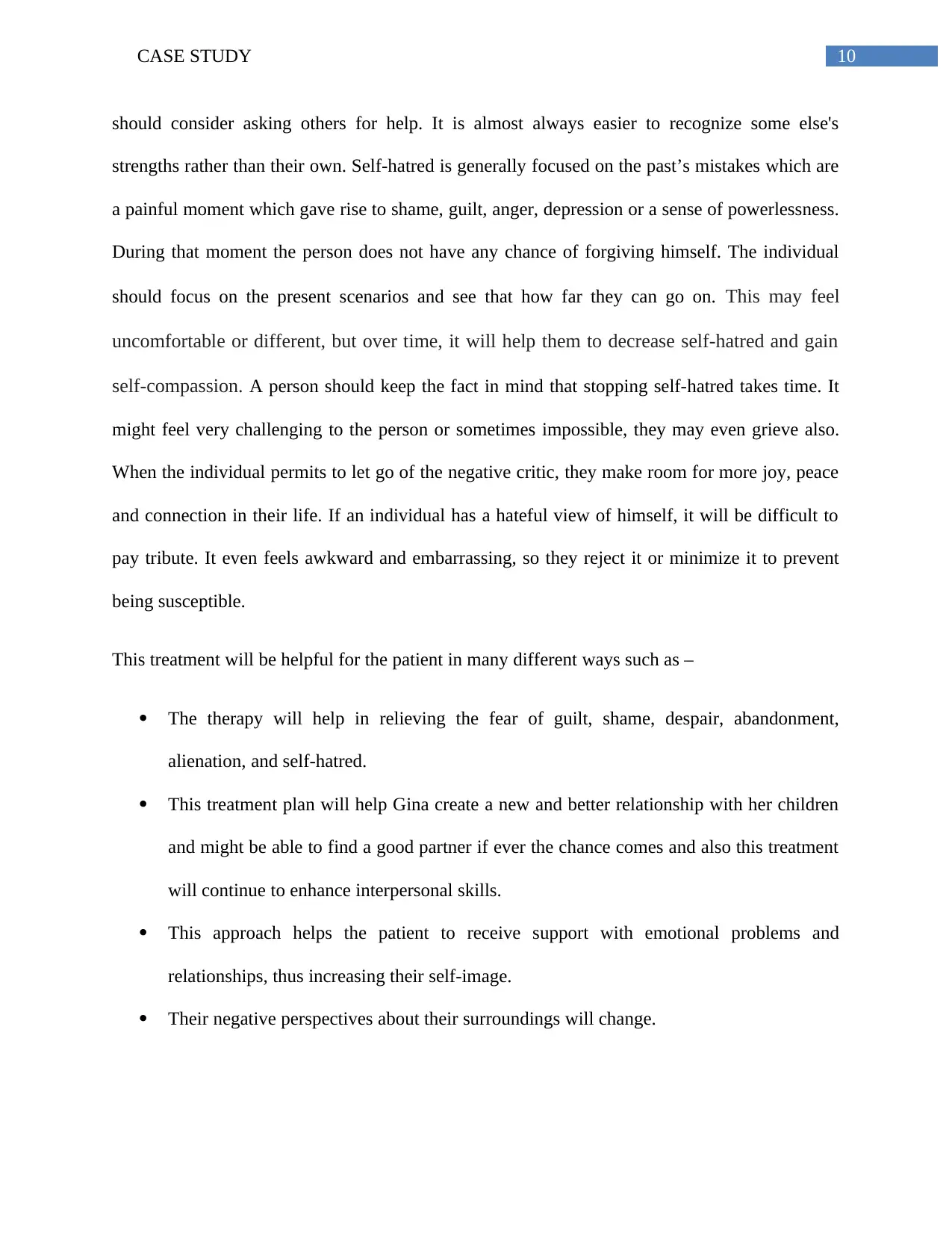
10CASE STUDY
should consider asking others for help. It is almost always easier to recognize some else's
strengths rather than their own. Self-hatred is generally focused on the past’s mistakes which are
a painful moment which gave rise to shame, guilt, anger, depression or a sense of powerlessness.
During that moment the person does not have any chance of forgiving himself. The individual
should focus on the present scenarios and see that how far they can go on. This may feel
uncomfortable or different, but over time, it will help them to decrease self-hatred and gain
self-compassion. A person should keep the fact in mind that stopping self-hatred takes time. It
might feel very challenging to the person or sometimes impossible, they may even grieve also.
When the individual permits to let go of the negative critic, they make room for more joy, peace
and connection in their life. If an individual has a hateful view of himself, it will be difficult to
pay tribute. It even feels awkward and embarrassing, so they reject it or minimize it to prevent
being susceptible.
This treatment will be helpful for the patient in many different ways such as –
The therapy will help in relieving the fear of guilt, shame, despair, abandonment,
alienation, and self-hatred.
This treatment plan will help Gina create a new and better relationship with her children
and might be able to find a good partner if ever the chance comes and also this treatment
will continue to enhance interpersonal skills.
This approach helps the patient to receive support with emotional problems and
relationships, thus increasing their self-image.
Their negative perspectives about their surroundings will change.
should consider asking others for help. It is almost always easier to recognize some else's
strengths rather than their own. Self-hatred is generally focused on the past’s mistakes which are
a painful moment which gave rise to shame, guilt, anger, depression or a sense of powerlessness.
During that moment the person does not have any chance of forgiving himself. The individual
should focus on the present scenarios and see that how far they can go on. This may feel
uncomfortable or different, but over time, it will help them to decrease self-hatred and gain
self-compassion. A person should keep the fact in mind that stopping self-hatred takes time. It
might feel very challenging to the person or sometimes impossible, they may even grieve also.
When the individual permits to let go of the negative critic, they make room for more joy, peace
and connection in their life. If an individual has a hateful view of himself, it will be difficult to
pay tribute. It even feels awkward and embarrassing, so they reject it or minimize it to prevent
being susceptible.
This treatment will be helpful for the patient in many different ways such as –
The therapy will help in relieving the fear of guilt, shame, despair, abandonment,
alienation, and self-hatred.
This treatment plan will help Gina create a new and better relationship with her children
and might be able to find a good partner if ever the chance comes and also this treatment
will continue to enhance interpersonal skills.
This approach helps the patient to receive support with emotional problems and
relationships, thus increasing their self-image.
Their negative perspectives about their surroundings will change.
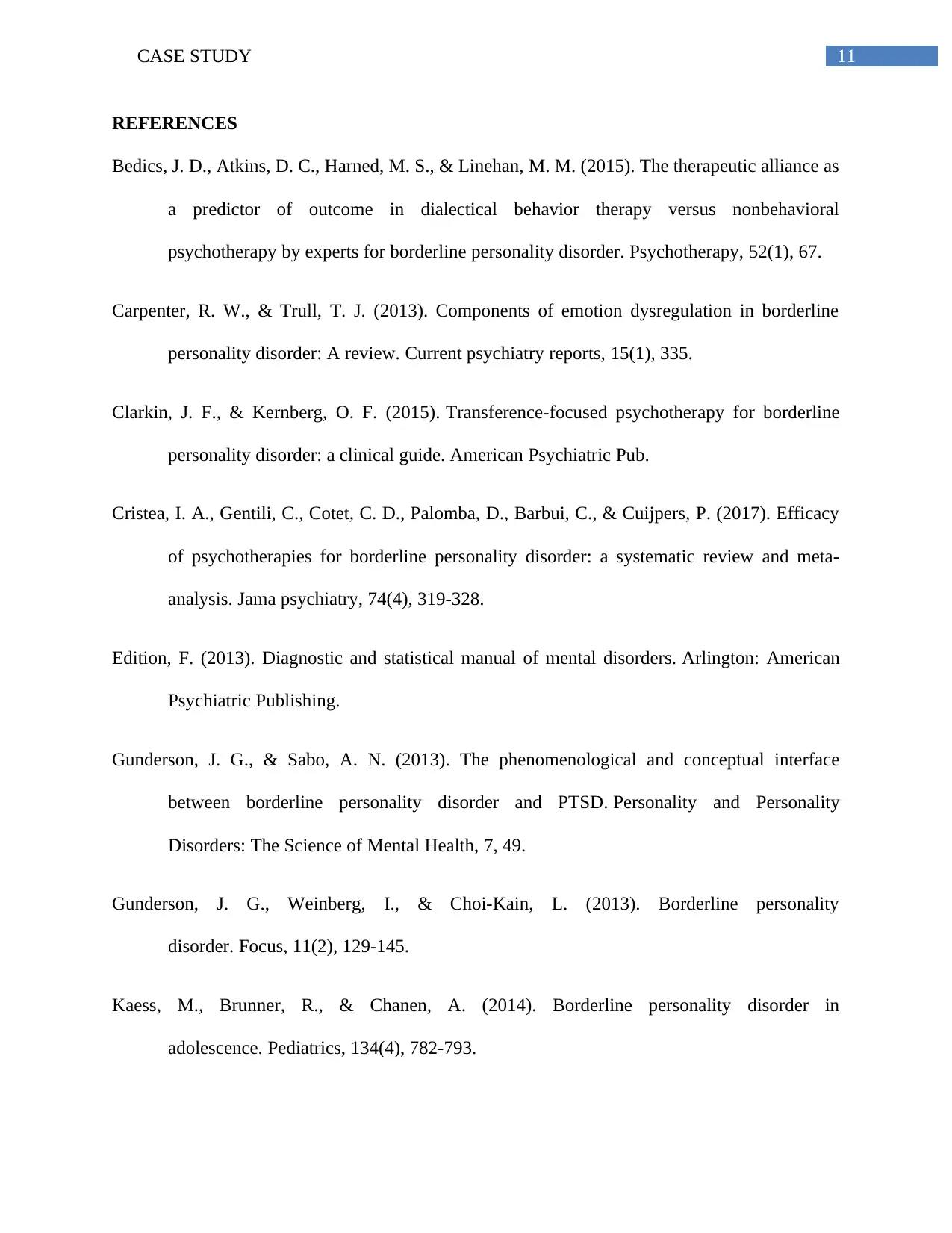
11CASE STUDY
REFERENCES
Bedics, J. D., Atkins, D. C., Harned, M. S., & Linehan, M. M. (2015). The therapeutic alliance as
a predictor of outcome in dialectical behavior therapy versus nonbehavioral
psychotherapy by experts for borderline personality disorder. Psychotherapy, 52(1), 67.
Carpenter, R. W., & Trull, T. J. (2013). Components of emotion dysregulation in borderline
personality disorder: A review. Current psychiatry reports, 15(1), 335.
Clarkin, J. F., & Kernberg, O. F. (2015). Transference-focused psychotherapy for borderline
personality disorder: a clinical guide. American Psychiatric Pub.
Cristea, I. A., Gentili, C., Cotet, C. D., Palomba, D., Barbui, C., & Cuijpers, P. (2017). Efficacy
of psychotherapies for borderline personality disorder: a systematic review and meta-
analysis. Jama psychiatry, 74(4), 319-328.
Edition, F. (2013). Diagnostic and statistical manual of mental disorders. Arlington: American
Psychiatric Publishing.
Gunderson, J. G., & Sabo, A. N. (2013). The phenomenological and conceptual interface
between borderline personality disorder and PTSD. Personality and Personality
Disorders: The Science of Mental Health, 7, 49.
Gunderson, J. G., Weinberg, I., & Choi-Kain, L. (2013). Borderline personality
disorder. Focus, 11(2), 129-145.
Kaess, M., Brunner, R., & Chanen, A. (2014). Borderline personality disorder in
adolescence. Pediatrics, 134(4), 782-793.
REFERENCES
Bedics, J. D., Atkins, D. C., Harned, M. S., & Linehan, M. M. (2015). The therapeutic alliance as
a predictor of outcome in dialectical behavior therapy versus nonbehavioral
psychotherapy by experts for borderline personality disorder. Psychotherapy, 52(1), 67.
Carpenter, R. W., & Trull, T. J. (2013). Components of emotion dysregulation in borderline
personality disorder: A review. Current psychiatry reports, 15(1), 335.
Clarkin, J. F., & Kernberg, O. F. (2015). Transference-focused psychotherapy for borderline
personality disorder: a clinical guide. American Psychiatric Pub.
Cristea, I. A., Gentili, C., Cotet, C. D., Palomba, D., Barbui, C., & Cuijpers, P. (2017). Efficacy
of psychotherapies for borderline personality disorder: a systematic review and meta-
analysis. Jama psychiatry, 74(4), 319-328.
Edition, F. (2013). Diagnostic and statistical manual of mental disorders. Arlington: American
Psychiatric Publishing.
Gunderson, J. G., & Sabo, A. N. (2013). The phenomenological and conceptual interface
between borderline personality disorder and PTSD. Personality and Personality
Disorders: The Science of Mental Health, 7, 49.
Gunderson, J. G., Weinberg, I., & Choi-Kain, L. (2013). Borderline personality
disorder. Focus, 11(2), 129-145.
Kaess, M., Brunner, R., & Chanen, A. (2014). Borderline personality disorder in
adolescence. Pediatrics, 134(4), 782-793.
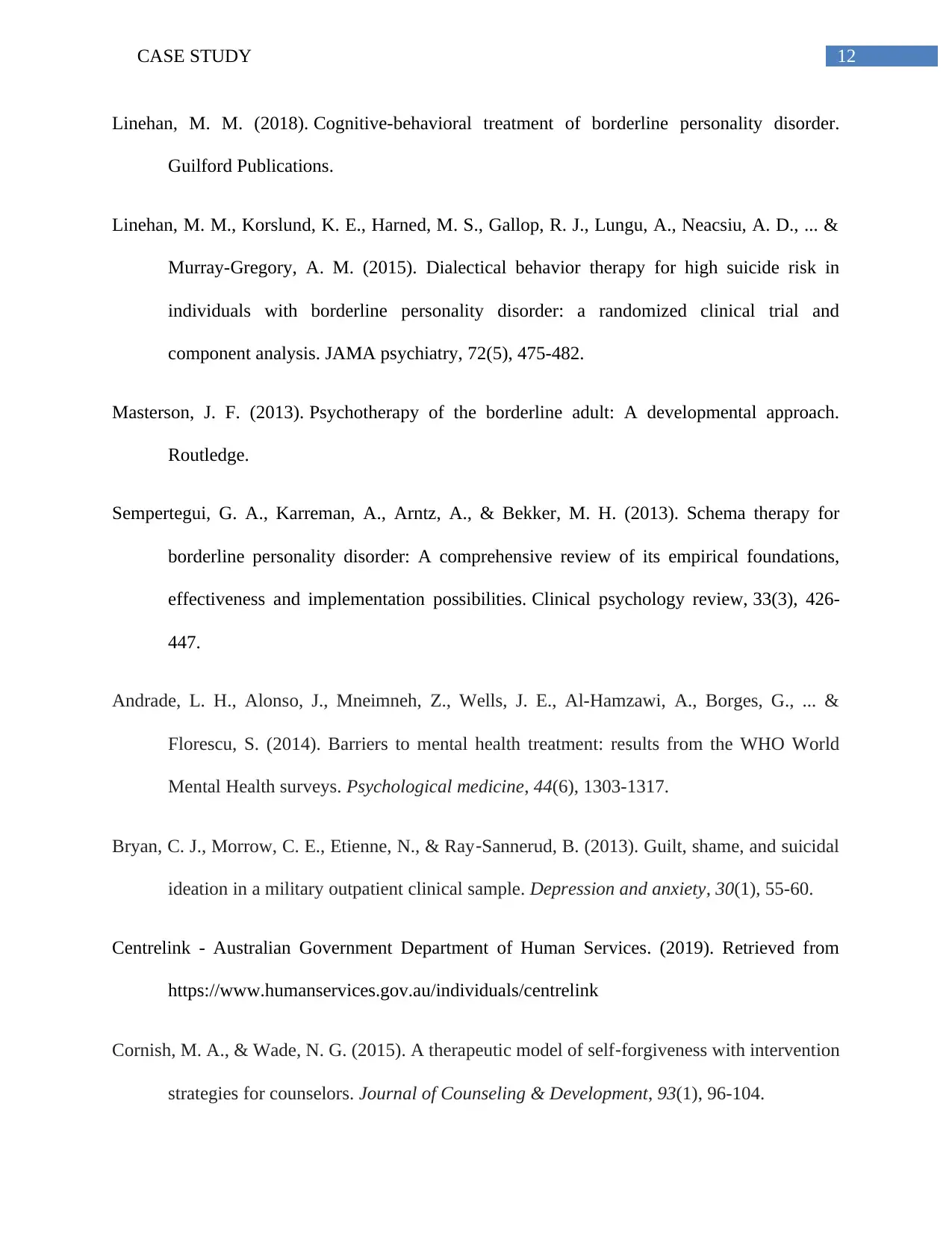
12CASE STUDY
Linehan, M. M. (2018). Cognitive-behavioral treatment of borderline personality disorder.
Guilford Publications.
Linehan, M. M., Korslund, K. E., Harned, M. S., Gallop, R. J., Lungu, A., Neacsiu, A. D., ... &
Murray-Gregory, A. M. (2015). Dialectical behavior therapy for high suicide risk in
individuals with borderline personality disorder: a randomized clinical trial and
component analysis. JAMA psychiatry, 72(5), 475-482.
Masterson, J. F. (2013). Psychotherapy of the borderline adult: A developmental approach.
Routledge.
Sempertegui, G. A., Karreman, A., Arntz, A., & Bekker, M. H. (2013). Schema therapy for
borderline personality disorder: A comprehensive review of its empirical foundations,
effectiveness and implementation possibilities. Clinical psychology review, 33(3), 426-
447.
Andrade, L. H., Alonso, J., Mneimneh, Z., Wells, J. E., Al-Hamzawi, A., Borges, G., ... &
Florescu, S. (2014). Barriers to mental health treatment: results from the WHO World
Mental Health surveys. Psychological medicine, 44(6), 1303-1317.
Bryan, C. J., Morrow, C. E., Etienne, N., & Ray‐Sannerud, B. (2013). Guilt, shame, and suicidal
ideation in a military outpatient clinical sample. Depression and anxiety, 30(1), 55-60.
Centrelink - Australian Government Department of Human Services. (2019). Retrieved from
https://www.humanservices.gov.au/individuals/centrelink
Cornish, M. A., & Wade, N. G. (2015). A therapeutic model of self‐forgiveness with intervention
strategies for counselors. Journal of Counseling & Development, 93(1), 96-104.
Linehan, M. M. (2018). Cognitive-behavioral treatment of borderline personality disorder.
Guilford Publications.
Linehan, M. M., Korslund, K. E., Harned, M. S., Gallop, R. J., Lungu, A., Neacsiu, A. D., ... &
Murray-Gregory, A. M. (2015). Dialectical behavior therapy for high suicide risk in
individuals with borderline personality disorder: a randomized clinical trial and
component analysis. JAMA psychiatry, 72(5), 475-482.
Masterson, J. F. (2013). Psychotherapy of the borderline adult: A developmental approach.
Routledge.
Sempertegui, G. A., Karreman, A., Arntz, A., & Bekker, M. H. (2013). Schema therapy for
borderline personality disorder: A comprehensive review of its empirical foundations,
effectiveness and implementation possibilities. Clinical psychology review, 33(3), 426-
447.
Andrade, L. H., Alonso, J., Mneimneh, Z., Wells, J. E., Al-Hamzawi, A., Borges, G., ... &
Florescu, S. (2014). Barriers to mental health treatment: results from the WHO World
Mental Health surveys. Psychological medicine, 44(6), 1303-1317.
Bryan, C. J., Morrow, C. E., Etienne, N., & Ray‐Sannerud, B. (2013). Guilt, shame, and suicidal
ideation in a military outpatient clinical sample. Depression and anxiety, 30(1), 55-60.
Centrelink - Australian Government Department of Human Services. (2019). Retrieved from
https://www.humanservices.gov.au/individuals/centrelink
Cornish, M. A., & Wade, N. G. (2015). A therapeutic model of self‐forgiveness with intervention
strategies for counselors. Journal of Counseling & Development, 93(1), 96-104.
Paraphrase This Document
Need a fresh take? Get an instant paraphrase of this document with our AI Paraphraser
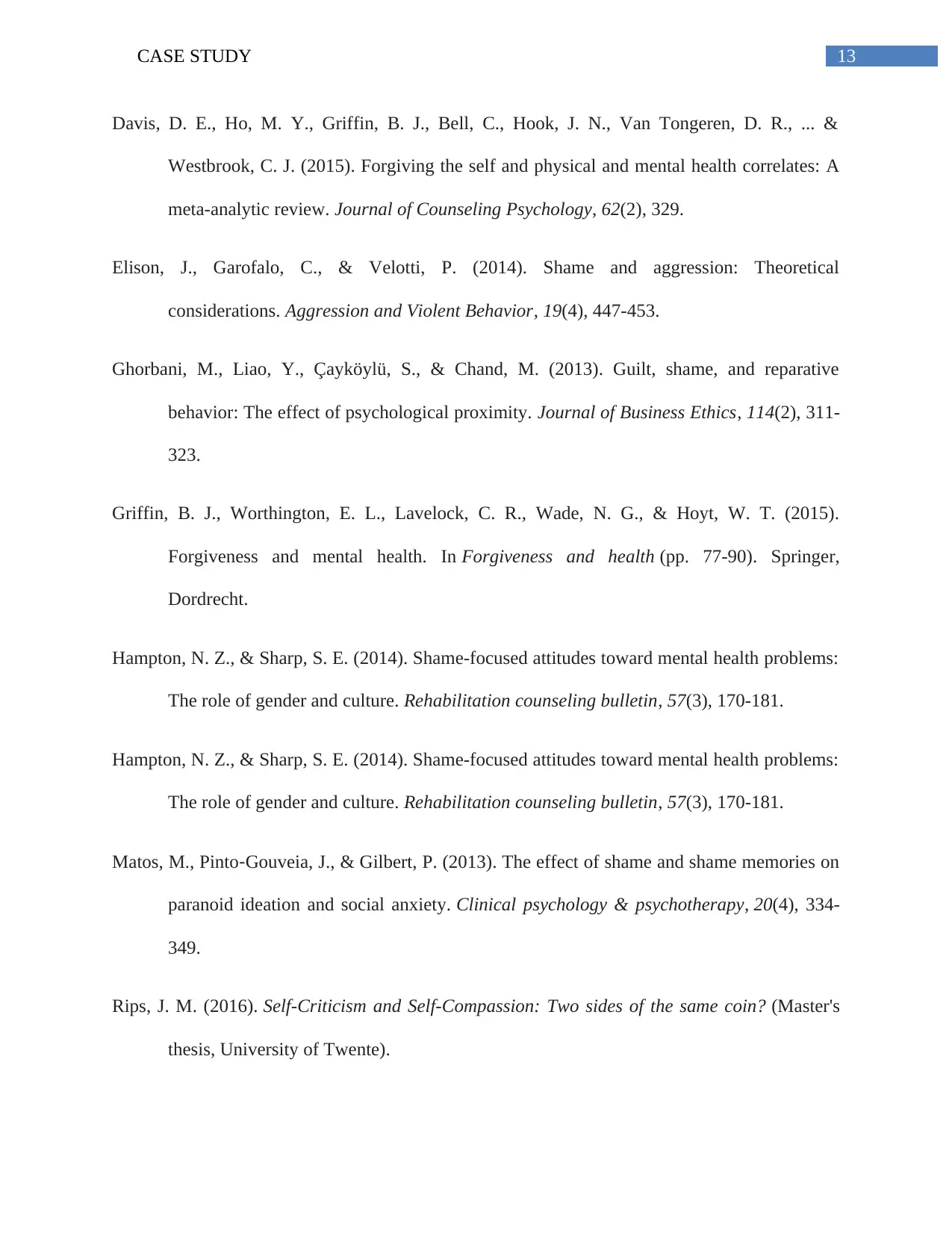
13CASE STUDY
Davis, D. E., Ho, M. Y., Griffin, B. J., Bell, C., Hook, J. N., Van Tongeren, D. R., ... &
Westbrook, C. J. (2015). Forgiving the self and physical and mental health correlates: A
meta-analytic review. Journal of Counseling Psychology, 62(2), 329.
Elison, J., Garofalo, C., & Velotti, P. (2014). Shame and aggression: Theoretical
considerations. Aggression and Violent Behavior, 19(4), 447-453.
Ghorbani, M., Liao, Y., Çayköylü, S., & Chand, M. (2013). Guilt, shame, and reparative
behavior: The effect of psychological proximity. Journal of Business Ethics, 114(2), 311-
323.
Griffin, B. J., Worthington, E. L., Lavelock, C. R., Wade, N. G., & Hoyt, W. T. (2015).
Forgiveness and mental health. In Forgiveness and health (pp. 77-90). Springer,
Dordrecht.
Hampton, N. Z., & Sharp, S. E. (2014). Shame-focused attitudes toward mental health problems:
The role of gender and culture. Rehabilitation counseling bulletin, 57(3), 170-181.
Hampton, N. Z., & Sharp, S. E. (2014). Shame-focused attitudes toward mental health problems:
The role of gender and culture. Rehabilitation counseling bulletin, 57(3), 170-181.
Matos, M., Pinto‐Gouveia, J., & Gilbert, P. (2013). The effect of shame and shame memories on
paranoid ideation and social anxiety. Clinical psychology & psychotherapy, 20(4), 334-
349.
Rips, J. M. (2016). Self-Criticism and Self-Compassion: Two sides of the same coin? (Master's
thesis, University of Twente).
Davis, D. E., Ho, M. Y., Griffin, B. J., Bell, C., Hook, J. N., Van Tongeren, D. R., ... &
Westbrook, C. J. (2015). Forgiving the self and physical and mental health correlates: A
meta-analytic review. Journal of Counseling Psychology, 62(2), 329.
Elison, J., Garofalo, C., & Velotti, P. (2014). Shame and aggression: Theoretical
considerations. Aggression and Violent Behavior, 19(4), 447-453.
Ghorbani, M., Liao, Y., Çayköylü, S., & Chand, M. (2013). Guilt, shame, and reparative
behavior: The effect of psychological proximity. Journal of Business Ethics, 114(2), 311-
323.
Griffin, B. J., Worthington, E. L., Lavelock, C. R., Wade, N. G., & Hoyt, W. T. (2015).
Forgiveness and mental health. In Forgiveness and health (pp. 77-90). Springer,
Dordrecht.
Hampton, N. Z., & Sharp, S. E. (2014). Shame-focused attitudes toward mental health problems:
The role of gender and culture. Rehabilitation counseling bulletin, 57(3), 170-181.
Hampton, N. Z., & Sharp, S. E. (2014). Shame-focused attitudes toward mental health problems:
The role of gender and culture. Rehabilitation counseling bulletin, 57(3), 170-181.
Matos, M., Pinto‐Gouveia, J., & Gilbert, P. (2013). The effect of shame and shame memories on
paranoid ideation and social anxiety. Clinical psychology & psychotherapy, 20(4), 334-
349.
Rips, J. M. (2016). Self-Criticism and Self-Compassion: Two sides of the same coin? (Master's
thesis, University of Twente).
1 out of 14
Related Documents
Your All-in-One AI-Powered Toolkit for Academic Success.
+13062052269
info@desklib.com
Available 24*7 on WhatsApp / Email
![[object Object]](/_next/static/media/star-bottom.7253800d.svg)
Unlock your academic potential
© 2024 | Zucol Services PVT LTD | All rights reserved.





